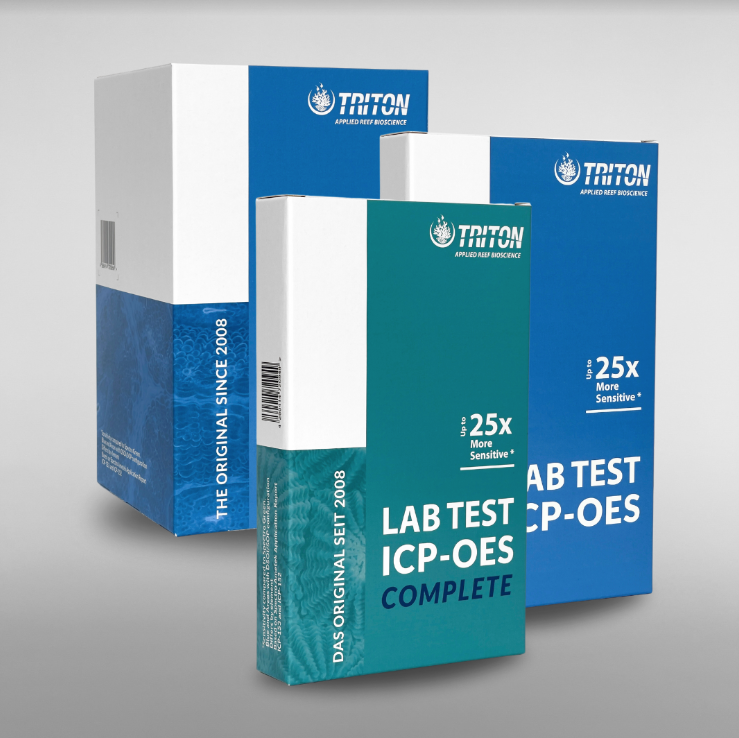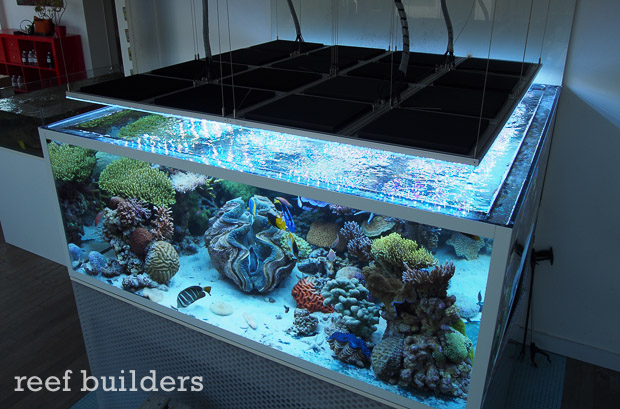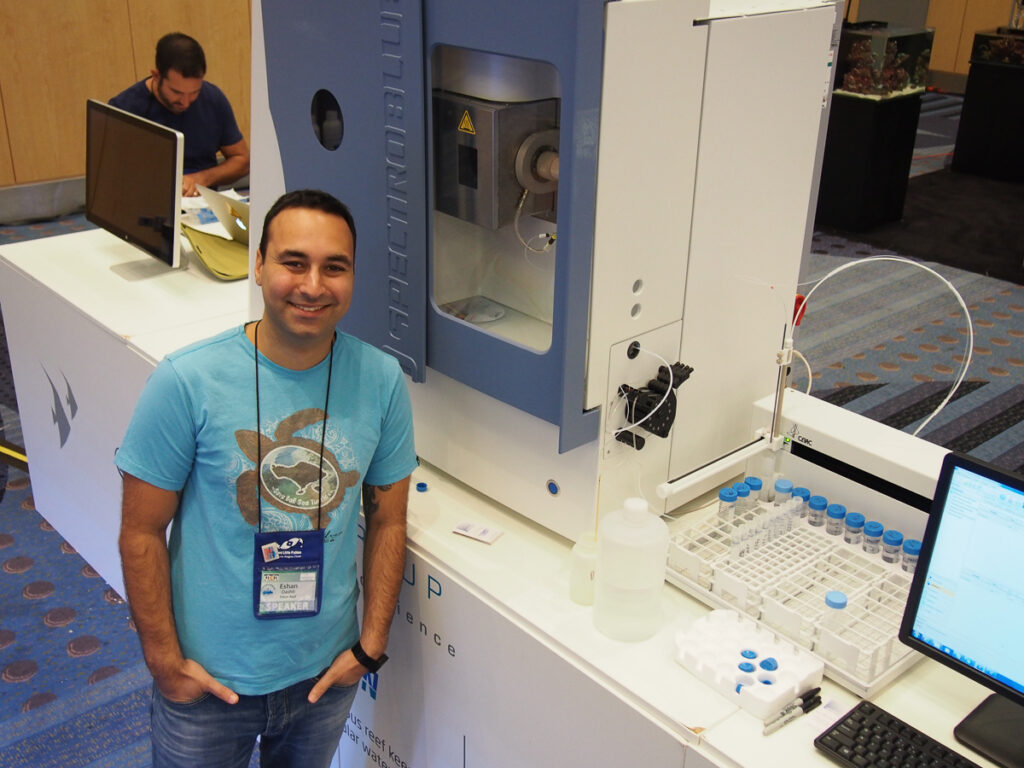With 16 years of experience and over 500,000 aquarium ICP tests under his belt, we spoke to global pioneer Ehsan Dashti and got his take on ICP testing, important trace elements, algae refugiums, overdosing, N-DOC, and more.
How often should someone ICP test their reef aquarium?
Depending on the type of reef keeping. A standard reef keeper with an SPS aquarium, running the TRITON Method, and testing every three months is sufficient. Any other system, without a holistic approach, should need to test every one to two months as the possibility of error is higher.
What are your thoughts on ICP testing a tank when the corals are all looking good, and then maintaining those parameters versus a traffic light system and trace element levels in the ocean?
First of all the traffic light system is not reflecting the ocean. This system is based on our research, which is unique to TRITON, over the past decade. TRITON moved, a long time ago, from a traffic light to an analog bar system which is much more helpful and usable. Anyway, a healthy aquarium is a momentary picture while an ICP test can give you conclusions of what can happen in the future. For example, you can have a very nice tank with 5 micrograms of Copper (Cu). The next time you test you have 10 micrograms of Cu and the aquarium still looks good. When you reach 20 micrograms of Cu the coral bleaching will start. The ICP test would have told you to do something about the Cu contamination before the bleaching occurred. Not reacting to a trend of rising Cu because the tank looks good would be a massive mistake.
The other possibility is looking at the form of the element visible, in this case, we’ll keep using the example of Cu. You could have a reading of 20 micrograms of “non-dangerous” Cu and the corals will still look good. The ICP would suggest that you reduce this Cu and the reason for that is that the Cu could change form due to uncontrollable circumstances in your aquarium, and be converted into a dangerous form of Cu. The logical approach here is to aim for undetectable Cu. This same example applies to a lot of other elements like Tin (Sn), Vanadium (V), Cobalt (Co), Chromium (Cr), etc…

The Triton Method recommends the addition of a large macroalgae bed before the protein skimmer. What are the main benefits of macroalgae to a reef tank, and what trace elements do macroalgae use up and need to be replenished?
The TRITON Method does not recommend the addition of a macroalgae bed it “requires” a macroalgae bed. You cannot run the full TRITON Method if you do not run all parts of the required filter. The main benefits of an algae bed, isolated from the TRITON Method, are highly available microfood sources for fish and coral, affordable and flexible nutrient reduction filtration and this filter is easier to control than bacterial filtration. However, when implemented into the TRITON Method, it also gives you optimal pH stability, adaptivity to the animals being kept, and also a higher and more nutritious food source. The trace elements needed for a healthy refugium are elements like Iron, Manganese, Iodine, Zinc, etc… which is a proprietary mix that we have developed over the past 16 years.
What’s your view on lighting macroalgae? 12-hour daytime, reverse 12 hours at night, or 24 hours continuous?
For the TRITON Method, we recommend 14HRS max in a reverse cycle to your display aquarium using T5 lighting (50% Blue and 50% White). I have tried all possible modifications, from 24HRS, higher wattage, LED/LEP lighting, and different spectrums but after 16 years now this still proves to be the most beneficial.
In the hundreds of thousands of Triton ICP tests carried out worldwide, what trends do you see in the majority of people’s water? What is consistently too high and too low?
We are now over 500,000 ICP tests and over this time, with four laboratories around the world, this question is more of a regional one. At my last talk for ReefStock Australia, I identified the most important trends for each country over the year and had planned to present the same talk this year, called “TRION Insights” but unfortunately it didn’t happen. Globally a short summation would be as follows:
US: High overdose rates for Trace Elements
Australia: Either very high or very low nutrient levels but overall one of the best water parameters as most are using natural seawater.
UK: Mixture of both. Mostly high Phosphate levels and trending toward Trace Element overdose.
I can’t go into details as to why, as it would be outside the scope of this interview, but given the opportunity in the future could explain some of the reasons.
What are the five most important trace elements that reef hobbyists should monitor, and dose?
Manganese, Vanadium, Iodine, Zinc, and Strontium. While Strontium is not a trace element it is very important for hard coral. For soft coral aquariums, Nickel would replace Strontium.
Does an ICP-OES machine account for salinity? How important is it to correct salinity before sending a test away?
The closer your salinity is to 35PSU the better for the results but in a practical way, it really doesn’t make a difference. I wouldn’t worry about correcting the salinity at all.
How long does an ICP test take once in the lab? Can a machine test multiple samples at once? What’s the process? Can someone get two different results by using the same water sample and the same machine?
From arrival to proper quality controlled results by an expert, it should take approximately 24HRS. Yes, a standard ICP-OES method can test around 20 samples per run and then requires cleaning. The process, in TRITON’s case, is a very involved protocol and cannot be adequately described in this short-form article. Generically the protocol is as follows: receive the sample, sample preparation, machine preparation (clean, standardize, calibrate, etc…), run the test, quality control of results by an expert, and upload to the customer’s account. Yes, there is a possibility that someone could get two different results for the same aquarium on the same machine. Differences can occur between two samples when taken, even if they are taken by the same person at the same time (eg. contamination). The machine tests the water in the vial not the water in the aquarium so whatever is in the vial can affect the results. However, we see these differences very rarely.
A recent Reef Builders article questioned the sample size for N-DOC, and how the ideal nutrient level recommendations were formed for a healthy tank. How many user’s tank data was used to determine which tanks were the healthiest?
I have read the article and most of the information is what I would consider OK. This question is one of the main reasons I founded TRITON as a marine aquarist myself. There was, and remains to this day, no alternative to TRITON’s findings in the field of HPLC, ICP, and N-DOC as we were the original and remain the most experienced in the marine aquarium industry. To the best of my knowledge, we are also the only company currently performing scientific work in this industry with a lab on the Great Barrier Reef alongside our multiple labs worldwide.
Questioning our analytical method regarding the sample size or the way we developed the ideal TRITON N:C:P ratio, to make our customers more successful, is not really the point. It is only a question of trust. Either you trust another person to assess whether our sample size is not big enough or you trust TRITON, the developer of almost all of the modern systems available to the industry today and running labs successfully for almost 16 years now. Secondly, what better alternative exists for the aquarist regarding the ideal N:C:P ratio, ICP set points, or any other form of analytical water quality analysis when compared to our scientific work and recommendations? Where are the companies or individuals putting more effort and investment into these areas than TRITON with professional employees, multiple labs, a research vessel, and a Scientific Division on the GBR? I would say that more importantly these questions should be asked. Realistically we are the only ones right now with an operational N-DOC machine for over 6 years so all the data collected is exclusive to TRITON and we’ll always be 6 years ahead of any competitor that brings this service to the industry. Always happy to answer detailed questions, without disclosing proprietary information, on any subject if asked.
We have heard a rumor you are to create your own Triton Tank 2.0. When will this happen and what sort of size and volume will the aquarium be?
Very soon and you can all read about it on ReefBuilders. Stay tuned!

Out of all the elements in the ocean, which ones aren’t important to corals? How important is it to dose amino acids and phytoplankton?
This is an absolute unknown. Different corals need different elements so this cannot be answered generically. It is even worse with the state of coral taxonomy in flux right now. As a scientist, I wouldn’t rule out any element that is common in reef water. In a TRITON Method system, it is not important as a lot of food is produced in the macroalgae refugium anyway. Regarding amino acids, I can see some benefits that I will communicate in the future. In my opinion amino acids, combined with N-DOC testing, are not a dangerous addition to the reef aquarium.
How important is the role of bacteria in a closed reef system? Will Triton ever produce a lab test for bacteria as it does for trace elements?
Bacteria is very important for a reef aquarium like many other life forms on the reef. Keeping a reef tank also means that you are keeping bacteria. A lot of work that we do is based on maintaining parameters to maintain all life forms, including bacteria, in a closed system. Even being able to really test for bacteria, this information would be useless for reef keeping, without the ability to manipulate the bacterial community within the aquarium. TRITON’s biological R&D is working in these areas right now.
Do trace element levels differ across a coral reef? Do some coral species need or prefer different trace elements to others?
Yes and Yes. Next year we are planning to report some of this information in an exciting way. Again, stay tuned!
What’s the most dangerous element to corals if overdosed?
Barium followed by Cobalt, Chromium, Copper, etc are some that come to mind straight away because these are the ones most often overdosed but every element in overdose can and will be toxic to the reef over a specific timeframe. As we often say… “The amounts make the toxin!”
Which elements are degraded or removed the quickest by our aquarium filtration systems?
Iodine, Manganese, Iron, Zinc, and Fluorine would be the most relevant but not only being taken by the filter. Their consumption is also taken up by precipitation and oxidization.
Is it generally a good thing to run activated carbon in a reef system, or a bad thing? Does carbon remove good things as well as bad, and is it okay to run activated carbon continuously?
In the TRITON Method, we run it continuously and it will take up good and bad things like every tool/product that you use on your aquarium. If you understand how the TRITON Method works, one of the things that make it unique is that we can overcome these problems with any filter media used.
If heavy metals are detected, many reefers reach for a bottle of Triton Detox. What does Detox remove?
Detox was designed mainly for Copper (Cu) where it is very effective as a binding agent but, over the years we have found, that it also works on Tin (Sn) and Lead (Pb) where its efficiency will slightly fluctuate.
What, in your opinion, is the biggest problem in reefkeeping right now?
Misinformation coming from sources that are not questioned enough. Modern reefkeepers do not investigate enough about who is providing them with advice and what defines this person’s core of expertise. I have worked extensively in the field of reef chemistry analysis for over 16 years but if you were to ask me about fish taxonomy I would not be qualified to provide advice. This opens up an opportunity for sales and marketing to take advantage and sell products quickly which spreads misinformation at the same time. This is and always is what hurts our industry the most.
What is, in your opinion, the biggest issue in lab testing right now?
In my opinion, it is the lack of transparency of who is performing your test, who is in charge of quality control, and who is giving you advice on what are the set points and where they come from. Lab testing overall in the way that I created it is not for hobbyists to guess and go on social media to ask questions about trace elements that they have never dealt with before. You need an expert to guide you in these areas. From what I have seen, based on the pure demand for these experts, people have jumped into areas outside their area of expertise and provided misinformation. I would advise that every reef keeper, before deciding on lab testing ask these three questions:
1) Who am I going to trust for my parameters?
2) How much experience does this company have in this field of testing?
3) What is their professional core expertise in the field of marine water analysis?

About the expert
Ehsan Dashti was the first to employ cutting-edge technology ( ICP, HPLC, NDOC ) to analyze artificial and natural seawater for aquarium professionals and hobbyists in 2008. He is the founder, owner, and CEO of TRITON until the present day.
Ehsan is an integral part of all TRITON research and development, lab testing, and product design. He relocated in 2018 to the Great Barrier Reef in Australia, to create a unique science division focusing his applied science on the largest coral reef ecosystem.
TRITON has become the industry leader in water biochemistry through the development of several groundbreaking innovations. Ehsan has presented talks, as a coral husbandry expert, at numerous international conferences around the world like the IAC, MACA, Pet South America, Pet ASIA, EUAC, and MACNA.



